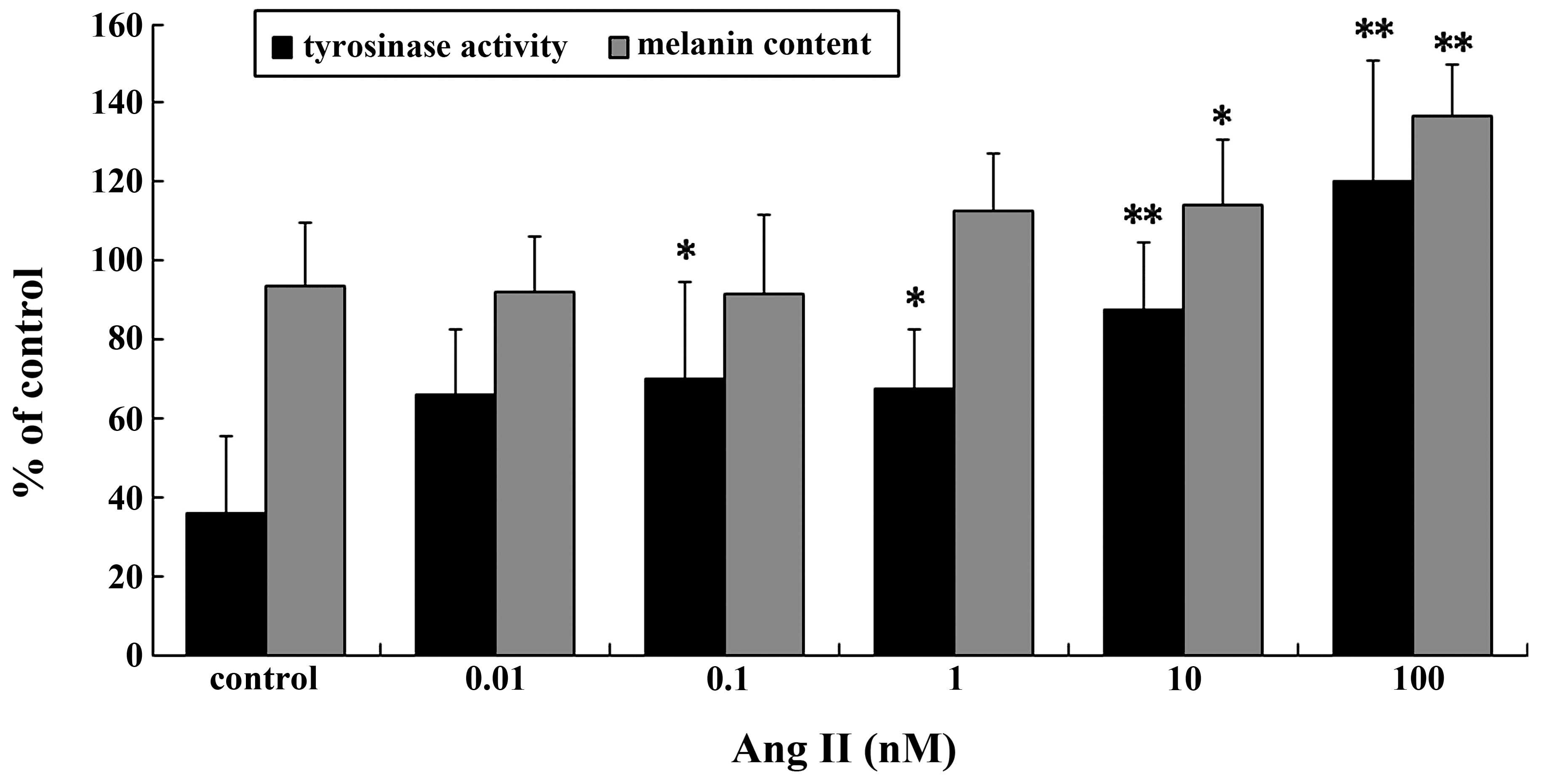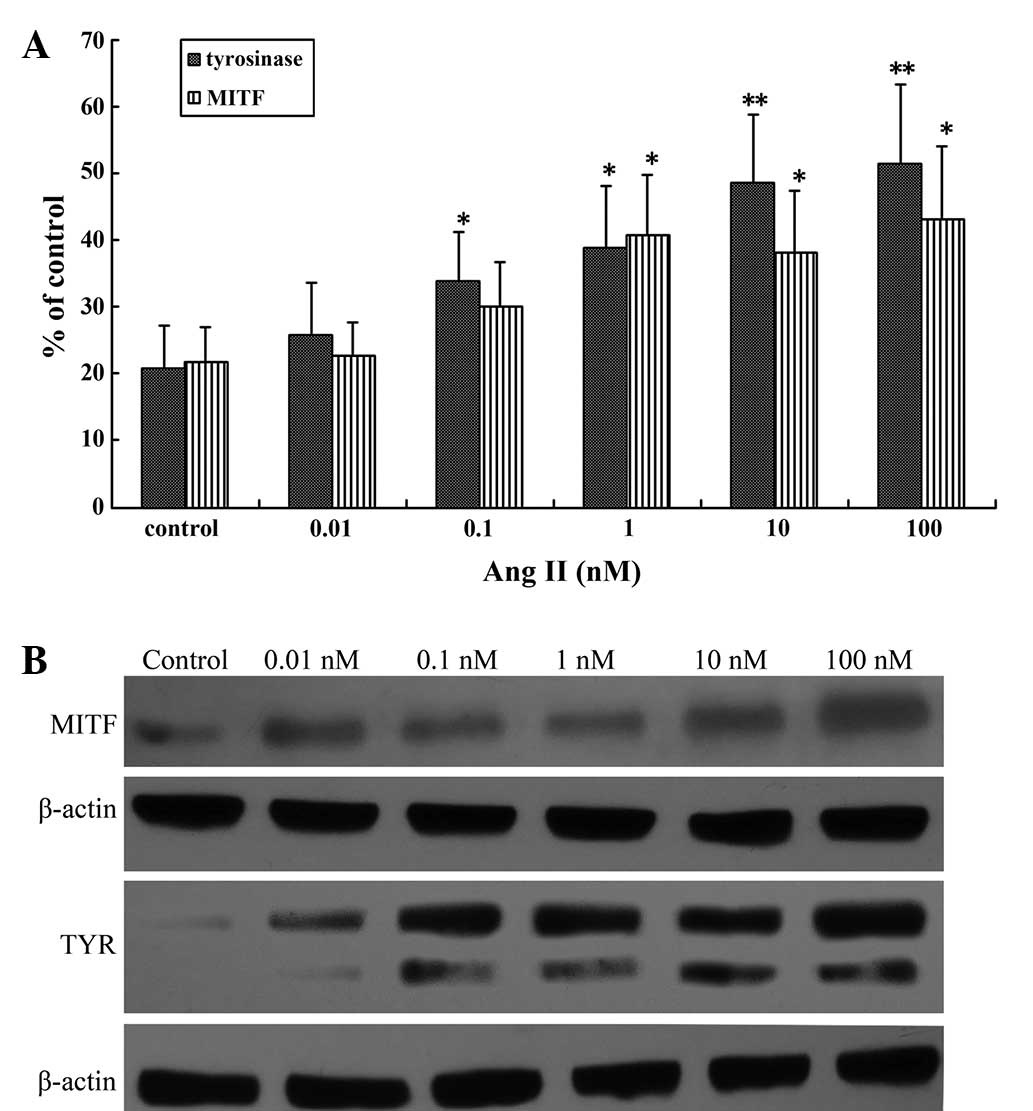|
1
|
Hirobe T: Proliferation of epidermal
melanocytes during the healing of skin wounds in newborn mice. J
Exp Zool. 227:423–431. 1983. View Article : Google Scholar : PubMed/NCBI
|
|
2
|
Tobin DJ: The cell biology of human hair
follicle pigmentation. Pigment Cell Melanoma Res. 24:75–88. 2011.
View Article : Google Scholar : PubMed/NCBI
|
|
3
|
Nishimura EK: Melanocyte stem cells: A
melanocyte reservoir in hair follicles for hair and skin
pigmentation. Pigment Cell Melanoma Res. 24:401–410. 2011.
View Article : Google Scholar : PubMed/NCBI
|
|
4
|
Ito M, Liu Y, Yang Z, Nguyen J, Liang F,
Morris RJ and Cotsarelis G: Stem cells in the hair follicle bulge
contribute to wound repair but not to homeostasis of the epidermis.
Nat Med. 11:1351–1354. 2005. View
Article : Google Scholar : PubMed/NCBI
|
|
5
|
McKinney CA, Fattah C, Loughrey CM,
Milligan G and Nicklin SA: Angiotensin-(1–7) and angiotensin-(1–9):
Function in cardiac and vascular remodelling. Clin Sci (Lond).
126:815–827. 2014. View Article : Google Scholar : PubMed/NCBI
|
|
6
|
RuizOrtega M, Lorenzo O, Rupérez M,
Esteban V, Suzuki Y, Mezzano S, Plaza JJ and Egido J: Role of the
renin-angiotensin system in vascular diseases: Expanding the field.
Hypertension. 38:1382–1387. 2001. View Article : Google Scholar : PubMed/NCBI
|
|
7
|
Takeda H, Katagata Y, Hozumi Y and Kondo
S: Effects of angiotensin II receptor signaling during skin wound
healing. Am J Pathol. 165:1653–1662. 2004. View Article : Google Scholar : PubMed/NCBI
|
|
8
|
Rodgers K, Abiko M, Girgis W, St Amand K,
Campeau J and di Zerega G: Acceleration of dermal tissue repair by
angiotensin II. Wound Repair Regen. 5:175–183. 1997. View Article : Google Scholar : PubMed/NCBI
|
|
9
|
Rodgers KE, DeCherney AH, St Amand KM,
Dougherty WR, Felix JC, Girgis WW and di Zerega GS: Histologic
alterations in dermal repair after thermal injury effects of
topical angiotensin II. J Burn Care Rehabil. 18:381–388. 1997.
View Article : Google Scholar : PubMed/NCBI
|
|
10
|
Nozawa Y, Matsuura N, Miyake H, Yamada S
and Kimura R: Effects of TH-142177 on angiotensin II-induced
proliferation, migration and intracellular signaling in vascular
smooth muscle cells and on neointimal thickening after balloon
injury. Life Sci. 64:2061–2070. 1999. View Article : Google Scholar : PubMed/NCBI
|
|
11
|
Steckelings UM, Wollschläger T, Peters J,
Henz BM, Hermes B and Artuc M: Human skin: Source of and target
organ for angiotensin II. Exp Dermatol. 13:148–154. 2004.
View Article : Google Scholar : PubMed/NCBI
|
|
12
|
Steckelings UM, Henz BM, Wiehstutz S,
Unger T and Artuc M: Differential expression of angiotensin
receptors in human cutaneous wound healing. Br J Dermatol.
153:887–893. 2005. View Article : Google Scholar : PubMed/NCBI
|
|
13
|
Otake AH, Mattar AL, Freitas HC, Machado
CM, Nonogaki S, Fujihara CK, Zatz R and Chammas R: Inhibition of
angiotensin II receptor 1 limits tumor-associated angiogenesis and
attenuates growth of murine melanoma. Cancer Chemother Pharmacol.
66:79–87. 2010. View Article : Google Scholar : PubMed/NCBI
|
|
14
|
Widlund HR and Fisher DE:
Microphthalamia-associated transcription factor: A critical
regulator of pigment cell development and survival. Oncogene.
22:3035–3041. 2003. View Article : Google Scholar : PubMed/NCBI
|
|
15
|
Lee AY and Noh M: The regulation of
epidermal melanogenesis via cAMP and/or PKC signaling pathways:
Insights for the development of hypopigmenting agents. Arch Pharm
Res. 36:792–801. 2013. View Article : Google Scholar : PubMed/NCBI
|
|
16
|
Buscà R and Ballotti R: Cyclic AMP a key
messenger in the regulation of skin pigmentation. Pigment Cell Res.
13:60–69. 2000. View Article : Google Scholar : PubMed/NCBI
|
|
17
|
Gordon PR and Gilchrest BA: Human
melanogenesis is stimulated by diacylglycerol. J Invest Dermatol.
93:700–702. 1989. View Article : Google Scholar : PubMed/NCBI
|
|
18
|
Park HY and Gilchrest BA: Signaling
pathways mediating melanogenesis. Cell Mol Biol (Noisy-le-grand).
45:919–930. 1999.PubMed/NCBI
|
|
19
|
LeiteMoreira AF, CastroChaves P,
PimentelNunes P, LimaCarneiro A, Guerra MS, Soares JB and
Ferreira-Martins J: Angiotensin II acutely decreases myocardial
stiffness: A novel AT1, PKC and Na+/H+
exchanger-mediated effect. Br J Pharmacol. 147:690–697. 2006.
View Article : Google Scholar : PubMed/NCBI
|
|
20
|
Berthold H, Just A, Kirchheim HR and Ehmke
H: Interaction between nitric oxide and endogenous vasoconstrictors
in control of renal blood flow. Hypertension. 34:1254–1258. 1999.
View Article : Google Scholar : PubMed/NCBI
|
|
21
|
Mehta PK and Griendling KK: Angiotensin II
cell signaling: Physiological and pathological effects in the
cardiovascular system. Am J Physiol Cell Physiol. 292:C82–C97.
2007. View Article : Google Scholar : PubMed/NCBI
|
|
22
|
Lei TC, Virador VM, Vieira WD and Hearing
VJ: A melanocyte-keratinocyte coculture model to assess regulators
of pigmentation in vitro. Anal Biochem. 305:260–268. 2002.
View Article : Google Scholar : PubMed/NCBI
|
|
23
|
Virador VM, Kobayashi N, Matsunaga J and
Hearing VJ: A standardized protocol for assessing regulators of
pigmentation. Anal Biochem. 270:207–219. 1999. View Article : Google Scholar : PubMed/NCBI
|
|
24
|
Marin-Castaño ME, Elliot SJ, Potier M,
Karl M, Striker LJ, Striker GE, Csaky KG and Cousins SW: Regulation
of estrogen receptors and MMP-2 expression by estrogens in human
retinal pigment epithelium. Invest Ophthalmol Vis Sci. 44:50–59.
2003. View Article : Google Scholar : PubMed/NCBI
|
|
25
|
Aksan I and Goding CR: Targeting the
microphthalmia basic helix-loop-helix-leucine zipper transcription
factor to a subset of E-box elements in vitro and in
vivo. Mol Cell Biol. 18:6930–6938. 1998.PubMed/NCBI
|
|
26
|
Halaban R, Pomerantz SH, Marshall S,
Lambert DT and Lerner AB: Regulation of tyrosinase in human
melanocytes grown in culture. J Cell Biol. 97:480–488. 1983.
View Article : Google Scholar : PubMed/NCBI
|
|
27
|
Bertolotto C, Abbe P, Hemesath TJ, Bille
K, Fisher DE, Ortonne JP and Ballotti R: Microphthalmia gene
product as a signal transducer in cAMP-induced differentiation of
melanocytes. J Cell Biol. 142:827–835. 1998. View Article : Google Scholar : PubMed/NCBI
|
|
28
|
Price ER, Horstmann MA, Wells AG,
Weilbaecher KN, Takemoto CM, Landis MW and Fisher DE:
alpha-Melanocyte-stimulating hormone signaling regulates expression
of microphthalmia, a gene deficient in Waardenburg syndrome. J Biol
Chem. 273:33042–33047. 1998. View Article : Google Scholar : PubMed/NCBI
|
|
29
|
Steckelings UM, Artuc M, Paul M, Stoll M
and Henz BM: Angiotensin II stimulates proliferation of primary
human keratinocytes via a non-AT1, non-AT2 angiotensin receptor.
Biochem Biophys Res Commun. 229:329–333. 1996. View Article : Google Scholar : PubMed/NCBI
|
|
30
|
Gaggioli C, Buscà R, Abbe P, Ortonne JP
and Ballotti R: Microphthalmia-associated transcription factor
(MITF) is required but is not sufficient to induce the expression
of melanogenic genes. Pigment Cell Res. 16:374–382. 2003.
View Article : Google Scholar : PubMed/NCBI
|
|
31
|
Shibahara S, Takeda K, Yasumoto K, Udono
T, Watanabe K, Saito H and Takahashi K: Microphthalmia-associated
transcription factor (MITF): Multiplicity in structure, function,
and regulation. J Investig Dermatol Symp Proc. 6:99–104. 2001.
View Article : Google Scholar : PubMed/NCBI
|
|
32
|
Park HY, Wu C, Yonemoto L, MurphySmith M,
Wu H, Stachur CM and Gilchrest BA: MITF mediates cAMP-induced
protein kinase C-beta expression in human melanocytes. Biochem J.
395:571–578. 2006. View Article : Google Scholar : PubMed/NCBI
|
|
33
|
Park HY, Lee J, González S, MiddelkampHup
MA, Kapasi S, Peterson S and Gilchrest BA: Topical application of a
protein kinase C inhibitor reduces skin and hair pigmentation. J
Invest Dermatol. 122:159–166. 2004. View Article : Google Scholar : PubMed/NCBI
|
|
34
|
Niles RM and Loewy BP: Induction of
protein kinase C in mouse melanoma cells by retinoic acid. Cancer
Res. 49:4483–4487. 1989.PubMed/NCBI
|
|
35
|
Park HY, Russakovsky V, Ao Y, Fernandez E
and Gilchrest BA: Alpha-melanocyte stimulating hormone-induced
pigmentation is blocked by depletion of protein kinase C. Exp Cell
Res. 227:70–79. 1996. View Article : Google Scholar : PubMed/NCBI
|
|
36
|
Molnar P, Perrault R, Louis S and Zahradka
P: The cyclic AMP response element-binding protein (CREB) mediates
smooth muscle cell proliferation in response to angiotensin II. J
Cell Commun Signal. 8:29–37. 2014. View Article : Google Scholar : PubMed/NCBI
|
|
37
|
Funakoshi Y, Ichiki T, Takeda K, Tokuno T,
Iino N and Takeshita A: Critical role of cAMP-response
element-binding protein for angiotensin II-induced hypertrophy of
vascular smooth muscle cells. J Biol Chem. 277:18710–18717. 2002.
View Article : Google Scholar : PubMed/NCBI
|
|
38
|
Chintalgattu V and Katwa LC: Role of
protein kinase C-delta in angiotensin II induced cardiac fibrosis.
Biochem Biophys Res Commun. 386:612–616. 2009. View Article : Google Scholar : PubMed/NCBI
|
|
39
|
Müller MW, Todorov V, Krämer BK and Kurtz
A: Angiotensin II inhibits renin gene transcription via the protein
kinase C pathway. Pflugers Arch. 444:499–505. 2002. View Article : Google Scholar : PubMed/NCBI
|













